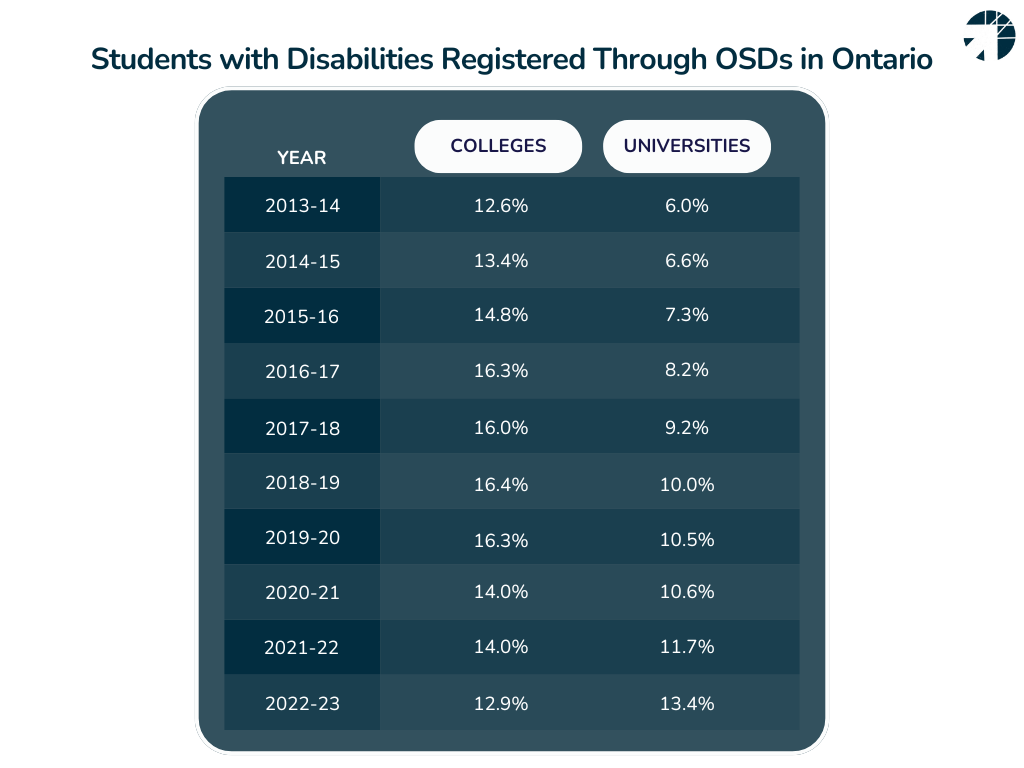For years, colleges have been seen as a primary destination for students with disabilities in Ontario. The smaller class sizes, applied learning focus and hands-on teaching models were often upheld as being more accessible. Data reinforced this perception — colleges consistently reported a higher proportion of students registering with Offices for Students with Disabilities (OSDs) than universities.
But recent data tells a different story. For the first time since 2013-14 — and maybe ever — the percentage of university students accessing OSD services has surpassed that of colleges. This marks a pivotal moment, challenging long-held assumptions about the demand for accessibility services in Ontario’s postsecondary institutions.
For the first time ever, the percentage of university students accessing OSD services has surpassed that of colleges.
What the Latest Data Reveals
While universities have seen a steady rise in OSD registrations, the college sector tells a more complex story. Between 2020 and 2022, the percentage of college students registering with OSD services dropped from 16.3% to 14%, and it fell further to 12.9% in 2022-23. By contrast, university registrations climbed to 13.4%, overtaking colleges for the first time (see the table below).

What explains this divergence? A closer look reveals that changing demographics in the college sector — particularly the growth in international student enrollments — played a key role.
The Impact of International Enrollments
In 2022-23, international students made up nearly half of all college student enrollments. Yet only 1.2% of international college students registered for OSD services, compared to 23.5% of domestic college students. This trend isn’t new. Since 2018, the proportion of international college students who registered for OSD services was consistently low, ranging from 1.2% to 2.1%. This stark contrast has reshaped the overall percentage of students accessing OSD support in colleges. As the number of international students in colleges grew, the overall percentage of college students accessing OSD services dropped.
High international enrollments obscure how many domestic students access college supports.
International students face unique barriers to using these services, including limited awareness of their availability, cultural stigma around disabilities, systemic challenges such as documentation requirements and limited financial assistance options. Given these obstacles, the issue of accessibility for international students remains an unresolved equity concern.
Meanwhile, universities are experiencing a steadily rising demand for accessibility services. This growth reflects the broader increase in enrollment among students with disabilities, a trend that shows no signs of slowing. As universities adapt to this intensifying need, it’s clear that resources for these services should scale accordingly. So far, this hasn’t been the case. Both college and university OSDs report facing challenges meeting the needs of students with disabilities at the current rates.
Meeting the needs of students with disabilities will require additional investment in these services.
Looking Ahead
Recent immigration and policy changes are expected to reshape enrollment patterns across Ontario’s postsecondary sector. As fewer international students enroll at Ontario colleges, domestic students will represent a higher proportion of overall enrolment. This shift will likely restore earlier trends, with colleges seeing a higher share of OSD registrations. However, this doesn’t mean universities will see a reprieve. If anything, the steady climb in demand for services in the university sector is a sign of enduring pressures needing to be addressed.
Meeting the needs of students with disabilities will require additional investment in these services. At the same time, the decline in international student enrollment adds another layer of complication. This will leave institutions struggling to balance the increased demand for disability services with other financial challenges, suggesting that funding for accessibility services may need to be re-examined.
For more information on HEQCO’s research into the trends and challenges in disability services funding, you can read the full report here.
